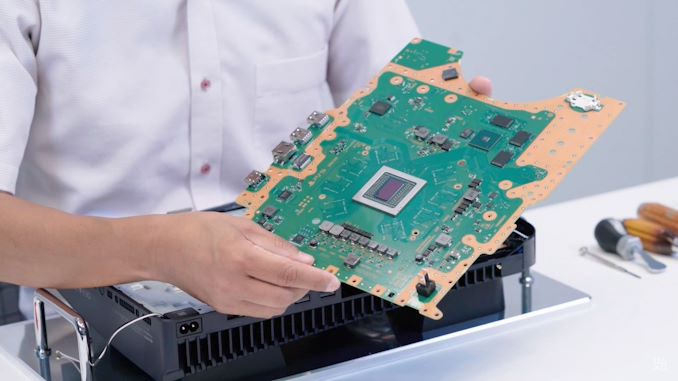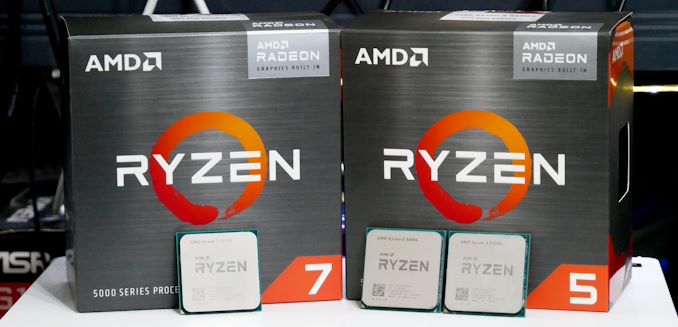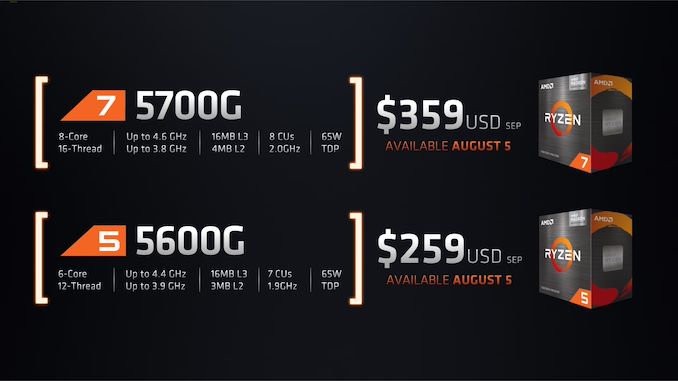The AMD Ryzen 7 5700G, Ryzen 5 5600G, and Ryzen 3 5300G Review
by Dr. Ian Cutress on August 4, 2021 1:45 PM ESTA Great Alternative to Regular Ryzen
I’m a big fan of a cheap and efficient solution for a PC that performs well and just works. Sometimes when building these systems, the fewer parts the better, as it means less can go wrong, but there is also a desire to ensure the system will last and remain fast during its tenure.
Historically a processor with integrated graphics fit the bill. They used to be a dime a dozen (or up to $150), and when paired with a good small motherboard and a couple of memory modules, an SSD, and a good stock cooler, then someone like my father can browse the web and do office stuff on his 32-inch display and join the weekly family zoom call without having to sit there for the system to respond.
What AMD has here with the new Ryzen 5000G desktop APUs is something that fast. Equipping up to eight Zen 3 cores around 4.0 GHz in a system should cater to almost* everyone’s compute needs. The new 5000G APUs are generationally a really nice improvement in raw compute performance over 4000G, but because 4000G wasn’t really at retail, we’re looking at 3000G, and the new hardware wipes the floor here. The only downside is that AMD didn’t release the cheapest offering.
Only the Ryzen 7 5700G ($359) and Ryzen 5 5600G ($259) are coming to market. Both of these processors are around about the same performance as their desktop variants (5800X and 5600X), so it probably won’t be much of a surprise to see these parts in our CPU guides going forward where we would normally recommend the X processors. The problem with these though is that the 5300G isn’t coming to market, at something like $159.
The Ryzen 3 5300G has been a fun processor to test. In every test it surpasses the previous retail APU flagship (the R5 3400G), and even if we compare it to the OEM flagship the R7 4750G, in a few tests it beats it there as well, both in regular performance and in gaming.
So why isn’t AMD selling the Ryzen 3 5300G at retail? Perhaps because it doesn’t need to. Demand for AMD’s regular processor lineup has been strong, and it is only recently where we’re seeing processors like the 5600X and 5800X come back down to MSRP and in stock regularly. AMD makes more profit on those processors (probably), so it would rather sell those. By keeping the 5300G behind, it drives users up to the mid and high-tier 5000G parts, increasing the average selling price and revenue. And in a market where all silicon seems to be being sold, it’s a clever productization tactic. The 5300G at a $159 price point would have a special place in many builds. Until that time, users will have to make do with a 5600G.
The Ryzen 7 5700G and Ryzen 5 5600G go on sale tomorrow, on August 5th 2021.
Do APUs Make Sense For Gaming Yet?
Ever since graphics hardware has been attached to CPU cores, we’ve always wondered: ‘At what point can it be powerful enough to consume the entry-level market?’. Theoretically, year on year, the graphics capabilities of what is in the silicon has improved, and we get speed increases in the same way we see CPU core performance increases. However it is not always the silicon that matters.
Games are also getting more complex. In the same way that every year we get more performance, every year the required specifications for modern games go up. Developers get ambitious, and they want to convert their artistic vision onto a system, and there are often two main targets for those developments: playable on consoles, and the best experience on a super expensive PC. This creates a problem for the lowly integrated graphics solution, because they end up powered well below that of consoles.

A PS5 Processor with Integrated Graphics
Consoles have the added benefit of being a hyper-optimized and well-defined platform: the software stack is built on gaming performance and developers can cater to it. Because integrated graphics can come in many different shapes and colors, we’re relying on some of those optimizations to filter down. Not only that but new technologies such as AMD’s Fidelity SuperFX Resolution are aimed at getting a better experience with less compute power. While game requirements are getting higher, at least the tricks to get better performance are also coming along.
So why not build a big integrated graphics solution for desktops, like a console? First is the market optics – realistically AMD is the main vendor in the console game but also the only vendor taking integrated graphics solutions seriously, so there’s no desire to cross-contaminate each market segment. Second is the market size – a discrete GPU, even one at 75 W, doesn’t have to compete with a joint power budget with a CPU, whereas an integrated solution does, and how many users really want a joint power budget for a main gaming system? One could easily argue that APUs make sense for those on a budget, or someone looking for a smaller system without a discrete card, and not a lot else.
On a budget, you could easily build a Ryzen 5 5600G gaming system with good recommended components for $621, providing you with almost the best integrated gaming experience while at the same time performing near-the-same or beating last generation’s flagship APU in day-to-day tasks. Moving up to Zen 3 with a larger L3 cache has really unlocked more of the performance in these cores and in the graphics.
One of the big questions on the horizon is regarding how AMD might use its 3D V-Cache technology in the future. The current implementation is a 64 MB die that sits on top of the cache in a regular CPU chiplet. That same chiplet won’t work on an APU, but AMD could very much design one in a similar fashion for its integrated graphics – perhaps adding another 32 MB of L3 cache. The question on that then becomes how much extra will it cost, and whether the trade-off is worth it. At a time where discrete graphics solutions are still crazy expensive, it is perhaps not as farfetched as you might think. However, based on AMD’s disclosures, don’t expect a chip like this anytime soon.












135 Comments
View All Comments
Cooe - Friday, August 6, 2021 - link
The recent GPU driver additions were NOT for Rembrandt. My guess is that's from some as of yet unannounced custom/embedded part for a market/use case where die size is absolutely CRITICAL (the only reason to pick RDNA over RDNA 2 is raw transistor density), that we're seeing there. Rembrandt otoh has had explicitly "RDNA 2" based graphics IP literally since it very first appeared on leaked AMD roadmaps YEARS ago, and it's consistently stayed "RDNA 2" in every future appearance/leaked roadmap.In fact with AMD's penchant for copy-pastaing reusable IP blocks across as many different products as they can, the iGPU implementation on Rembrandt is likely to be EXTREMELY similar to what is currently seen on Van Gogh (in fact, it wouldn't surprise me at ALL if they end up just sharing the exact same 8CU RDNA 2 iGPU block wholesale).
nandnandnand - Saturday, August 7, 2021 - link
https://www.notebookcheck.net/AMD-Ryzen-6000-Rembr..."Van Gogh is said to have eight compute units (CUs) per shader array with a 1 MB L2 cache while Rembrandt will have six CUs per shader array with 2 MB L2 cache, with the added cache possibly translating into improved gaming performance. It must be noted here that we still do not know the total number of CUs on the GPU, but rumors indicate up to 12 CUs for Rembrandt."
AThomas - Wednesday, August 4, 2021 - link
These APU's have my exact use case. Upgrading my HTPC which has trouble with HEVC codec (YouTube 4K) that can easily play PS2, PS1, Dreamcast, Sega 32X/CD, etc, etc. Plus Space Engineers which none of my rigs can play at the moment. All done with the iGPU at 60+FPS or better , also some Xbox titles like Forza Horizon since I don't play on buying a Xbox X.Second use is server. WIth a couple of VM's but mostly containers. Maybe throw a GPU in their for renting out GPU. All those threads will allow lots of functional task to be done.
Jorgp2 - Thursday, August 5, 2021 - link
AMDs APUs don't support GPU virtualizationGreenReaper - Sunday, August 15, 2021 - link
Not yet, no.boozed - Wednesday, August 4, 2021 - link
Are you sure?eastcoast_pete - Thursday, August 5, 2021 - link
Hush now! Ian was spilling Intel's newest acquisition plans..ballsystemlord - Wednesday, August 4, 2021 - link
In addition to what Dan said above your table entitled, "Ryzen 5 APUs (65W)" Is completely wrong. The 5600G is a 6 core processor and I suspect some of the other entries are incorrect also.Rudde - Wednesday, August 4, 2021 - link
"The second part is a Ryzen 5 5600G, featuring six cores and sixteen threads, with a base frequency of 3.9 GHz and a turbo frequency of 4.6 GHz. "This sentence has suffered from some copy and pasting. 12 threads and 4.4 GHz boost.
nandnandnand - Wednesday, August 4, 2021 - link
"However slow quad cores (like the 2400G still let you down."Missing closing parenthesis mark.